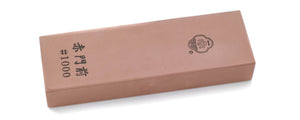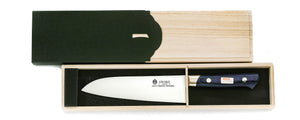Sharpening Stainless Steel Knives
Stainless steel knives are incredibly commonplace these days. Around a quarter of the ground floor of our store has stainless steel knives for sale of all kinds!
Especially when it comes to using knives in the home, stainless steel is often chosen over traditional carbon steel for people's knife choices.
Stainless steel knives have some amazing advantages - in that they're resistant to rust and hold their edge for a long time. This heavily reduces how much time you need to put into maintaining them.
However, this also comes with some drawbacks, which are also well known - such as "they don't cut as well" and "they're impossible to sharpen."
This article aims to show that while stainless steel is very difficult to sharpen, it absolutely can be sharpened with the right tools and tricks to give you an amazing cutting experience while retaining the rust resistance it's known for.
Just what is stainless steel?
Just why stainless steel resistant to rust in the first place?
Stainless steel is an alloy steel whose main component is iron. It also contains 10.5% or more of chromium, and this alloy is characterized by its high corrosion resistance.
Knives like carbon steel knives rust because iron is oxidized by oxygen and water, but the high chromium amounts in stainless steel knives form a thin film called a passive film on the surface of the iron.
This film combines with oxygen before the iron does, making oxidized film, which prevents the knife from rusting.
Advantages of stainless steel knives
- Rust-resistant
- Easier to maintain than carbon steel
- Less likely to chip
Disadvantages of stainless steel knives
- Poor grip on the whetstone
- More difficult to get a sharp edge on compared to carbon steel
Why are stainless steel knives difficult to sharpen?
Many people think that stainless steel knives can't be sharpened or that they can't cut properly. That belief comes from people in the Japanese cuisine industry who are very accustomed to carbon steel knives such as White Steel #2, which is a high-purity steel known for its ease of sharpening. Comparing the two, they feel that stainless steel is more difficult to sharpen. And because it is quite difficult to sharpen in comparison, it's hard to get a stainless steel knife to a state where it cuts the way carbon steel knives do. That results in their conclusion that stainless steel is difficult to sharpen and can’t cut well, with the context “comparing to carbon steel knives” omitted.
Is stainless steel difficult to sharpen?
Nowadays, steel materials have evolved, and some stainless steels that are easy to sharpen are available on the market. But when we talk about "ease of sharpening", they are aren't as good at this as carbon steel knives are. This is because some carbon steels, such as White Steel, pursue sharpness and ease of sharpening over anything else, doing this by removing impurities. In turn, stainless steels sacrifice these benefits to make the steel more resistant to rusting.
As mentioned above, stainless steel contains 10.5% or more of chromium, and is an alloy steel containing other materials like molybdenum and vanadium to give the blade toughness (or stickiness) and wear resistance. Those elements make stainless steel a steel material with many impurities that makes some sharpeners (such as in our store) feel that the toughness of the knives is very strong and they slip somewhat on the whetstone. This means the knives don't sharpen properly as the knife needs to make proper contact and stick to the whetstone correctly. For this reason, stainless steel requires significantly more sharpening time invested than carbon steel, so it became general belief that stainless steel is difficult to sharpen.
Stainless steel is rust-resistant, not rust-proof.
There's a somewhat common misconception that stainless steel never rusts.
However, while stainless steel is indeed rust-resistant, it can rust if you're not careful.
Be careful of rust on stainless steel
When looking at rust on stainless steel knives, the most common type of rust is a very destructive type called pitting corrosion.
Rust on stainless steel occurs when the passive film is partially destroyed, which can happen from things like scratches, or leaving them in water or covered in salt or food dirt for too long. After this, pitting corrosion causes the rust to penetrate into the metal.
This rust is extremely troublesome and can cause major damage to the knife as it can't be removed.
The rust that has penetrated through the knife will leave a hole or "pit" in it, giving the knife a moth-eaten appearance, and the blade will always chip very easily even after sharpening.
If you see these white spots like the above, the blade can't be repaired back to its original state. This demonstrates that stainless steel knives can take more rust damage than carbon steel knives if they aren't properly cared for, so it's still important to be very careful with them.
How to properly sharpen stainless steel knives
Simply put, there is no difference in the technique you use to sharpen a stainless steel knife and a carbon steel knife. However, as mentioned above, stainless steel is hard and tough, so it has the disadvantage that the whetstone doesn't stick well and it's more difficult to sharpen compared to carbon steel.
This factors into your whetstone selection for sharpening stainless steel knives.
We tend to find stainless steel knives are less compatible with hard whetstones, as the whetstone's surface gets slippery and this makes these knives hard to sharpen as a result. You can get "soft" versions of certain kinds of whetstones that are better for stainless steel knives.
For example, we sell a #1000 Kirameki Medium Whetstone, however we also have a #1000 Soft-type Kirameki Medium Whetstone. While both will sharpen stainless steel knives, the soft-type will do a better job at it. They tend to release swarf quite well, and this allows for even stainless steel knives to get caught on the whetstone easily and thus sharpen better. We sell this stone both in-store and online!































